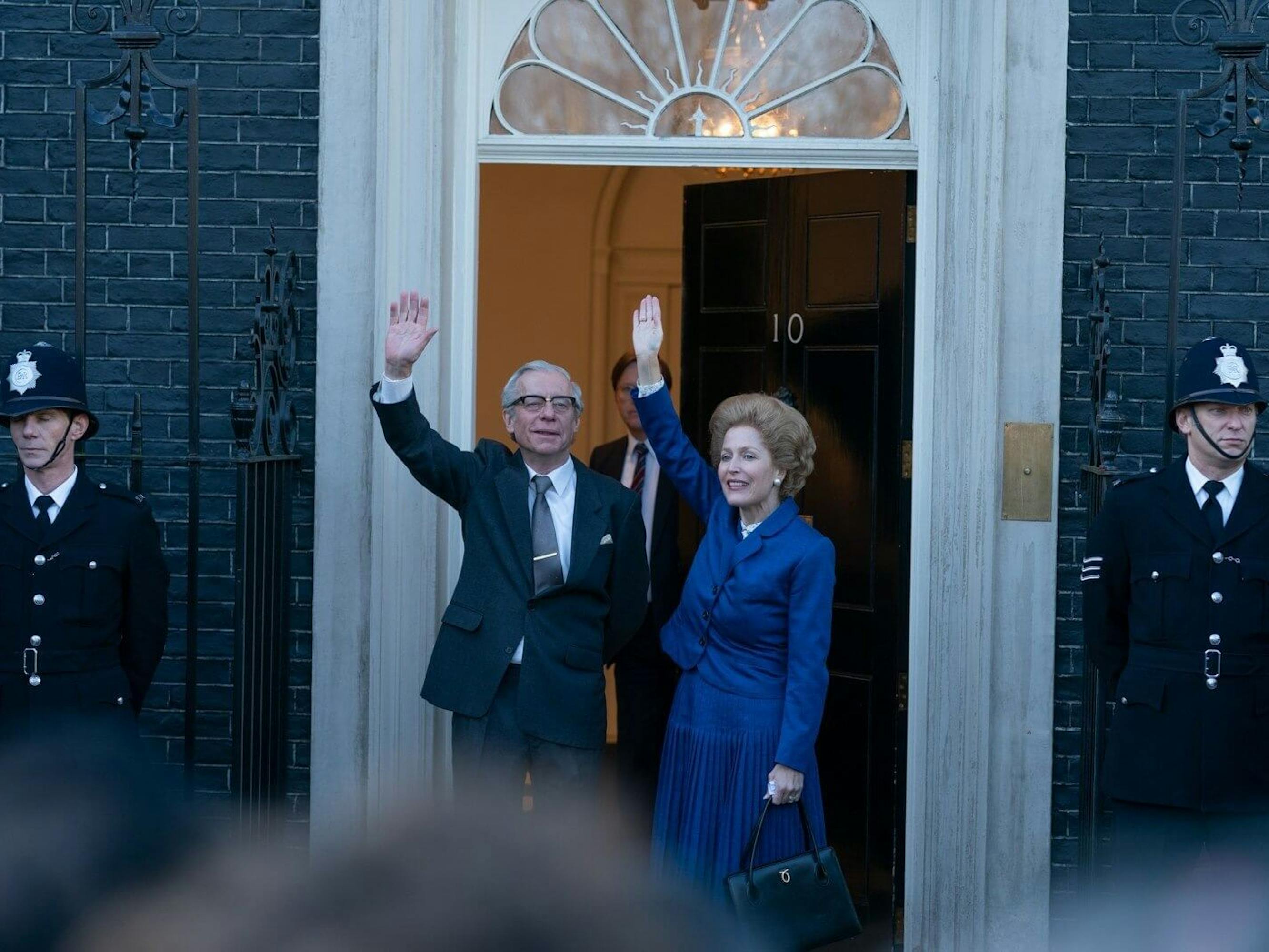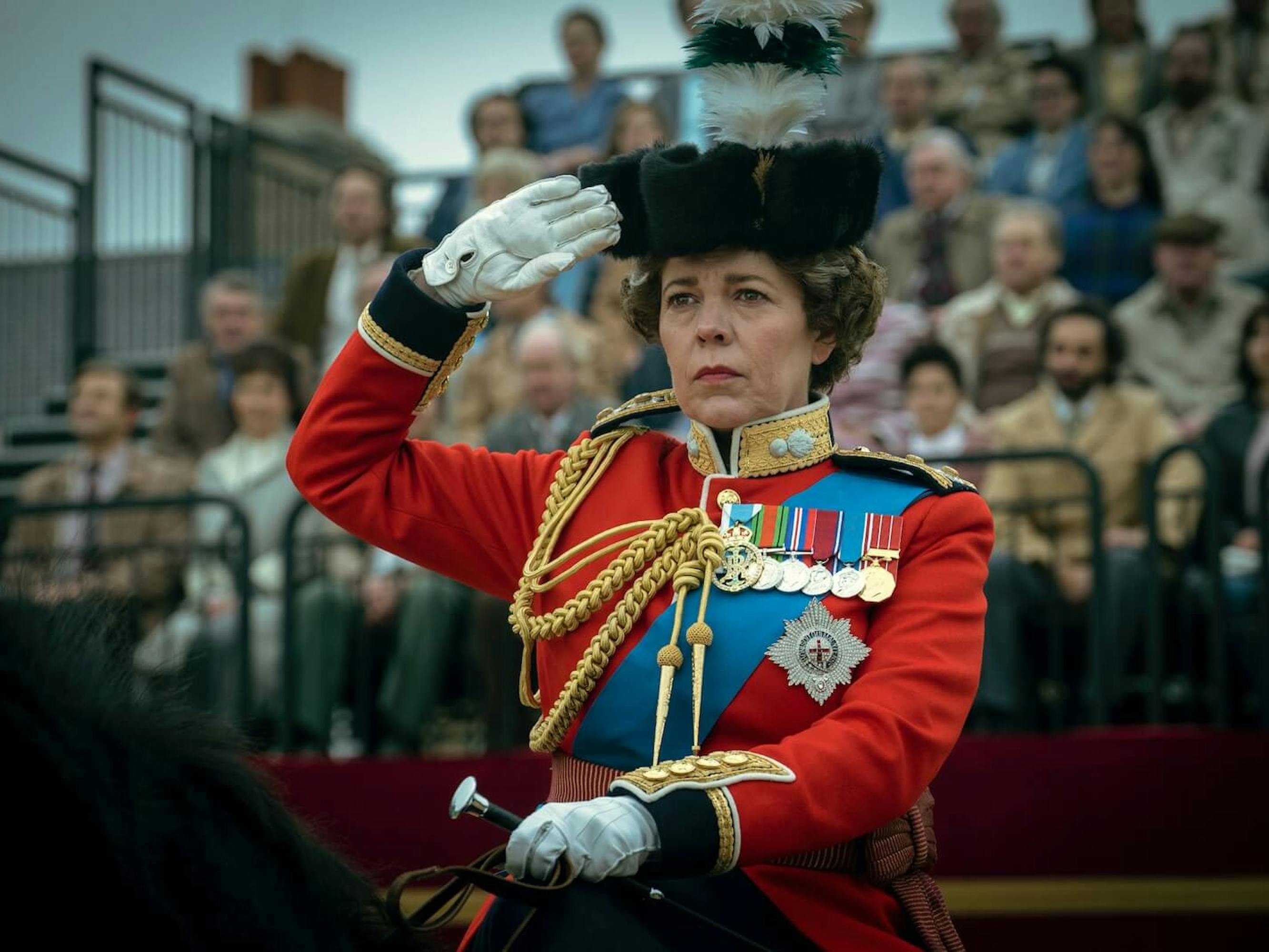The artisans and actors behind the Emmy-reigning The Crown tell us how they crafted another spectacular season.
The Crown director Ben Caron calls Season 4 “jam-packed.” Consider that an understatement about the show’s latest installment. The year is 1979: Margaret Thatcher has just been elected prime minister, and a young woman named Diana Spencer is set to marry her prince.
The fourth season reunites an award-winning cast that includes Olivia Colman as Queen Elizabeth II, Helena Bonham Carter as Princess Margaret, and Tobias Menzies as Prince Philip, as well as Josh O’Connor and Erin Doherty in the roles of Prince Charles and Princess Anne. The season also introduces two new stars to the mix: Gillian Anderson arrives as Thatcher, and Emma Corrin plays Diana.
As ever, The Crown Season 4 focuses on both political events and private moments behind palace walls. This time around, that balance is embodied by the relationship between two of the world’s most powerful women: Thatcher and the queen.“
On the face of it, Elizabeth and Margaret should get on,” says Colman. “They are the same age, have the same drive, the same devotion to their fathers, the same work ethic. Yet they don’t. It’s not the beautiful friendship that the queen hopes it will be at the beginning.” Adds Anderson: “Where the queen leans back, Thatcher leans in; where the queen does nothing, Thatcher takes action.” It is this conflict, says Crown creator Peter Morgan, “that is at the heart of Season 4.”
Another powerful presence is, of course, Diana, whom Corrin embodies from adolescence until age 28. Corrin plays the “people’s princess” with empathy, and she reflects that Diana “was able to radiate that brilliance and compassion that we all fell in love with, even when she was suffering.” For Morgan, writing Diana and Charles’s whole story was complicated. “You’re trying desperately to remain truthful, but you’re so burdened with what you know happens,” he says. “It’s very hard to write the innocent start to a relationship when you know how tragically it ended.”

Dennis Thatcher (Stephen Boxer) and Margaret Thatcher (Gillian Anderson)
Central for the actors is the knowledge that this is their last hurrah as an ensemble. Since the series’ genesis, Morgan has been clear about the importance of rotating in a new cast every two seasons. “The choice is simple. You can put lines on someone’s face or maybe digitally age them, but you can’t breathe the fatigue and bruises of life into a face,” he explains. “It’s like a relay race,” he says, describing this changing of the guard, “and you pass the baton.”
Before that happens, the cast pauses to celebrate their accomplishments, which include Golden Globes for Anderson, Corrin, and O’Connor, as well as a win for Best Drama Series; four BAFTA nominations; two SAG wins and 3 nominations; and 24 Emmy nominations (tied with The Mandalorian for the most nominations) including but not limited to two for Outstanding Directing, Outstanding Lead Actor, two for Outstanding Lead Actresses, Outstanding Supporting Actor, three for Outstanding Supporting Actress, Outstanding Drama Series, Outstanding Writing, and so on. The ensemble is also reveling in the lasting friendships they have made. “There’s that teasing and protecting and loving and joking that happens in families” Colman says. “It’s been the most enjoyable job of my life.”
I took a look behind the scenes to find out what it takes to make a royal success.
It’s not easy being a princess. That’s why the actors of The Crown are given hundred-page protocol “bibles” to study. In addition, a department of five researchers makes sure that the scripts and performances stay true to history. “As soon as you’re on board, they fill up your inbox,” Colman summarizes.
“The main part of being a member of the royal family is being seen,” says Bonham Carter. “If your one job is to get from a car to the door at whatever public event, you must go as slowly as possible. You have to maximize the amount of people who are going to see you. Hence, the royals move so slowly. That was the first thing we all had to get right.”
Even before they made their unhurried entrances on set, the stars had their work cut out for them. To play Princess Margaret, Bonham Carter pored through books and interviewed Margaret’s friends. Hair and makeup designer Cate Hall even arranged an educational meeting between Bonham Carter and Margaret’s former hairdresser, who treated them to a “tiara-application master class.”
Anderson, for her part, admits to “watching and reading everything I could.” She worked with movement and voice coaches to perfect Thatcher’s signature walk and manner of speech. “I listened to her voice a lot in private,” she says, “and spoke in that voice out loud when no one could hear.”

Prince Charles (Josh O’Connor)
Corrin also had a movement coach who counseled her on the minutest details, including how to stand in a doorway as Diana. Dance lessons helped the actor tap into the princess’s joy, and a meeting with the royal’s former private secretary, Patrick Jephson, revealed not only how much Diana suffered in her marriage, but also her essential effervescence: “He said she had a sense of fun that was contagious,” reveals Corrin.
The biggest stumbling block for some of the cast was their lack of horse sense. “I had that classic chat in my first audition where I just said, ‘Yes, I can ride!’” remembers Doherty. In reality, she had never been on a horse in her life, though that didn’t stop her from trying out for the role of Anne, who was an Olympic equestrian. “I wasn’t going to take myself out of the running,” Doherty says with a laugh. “For the first year I got away with it, and then they said they would give me lessons.”
Zooming out, any Crown fanatic would be hard-pressed to find fault with this meticulous and marvelous world. “It’s the most childlike thing when you come onto the fantastic sets, like being in a play,” says Menzies. “That’s been a particular joy.”
“Three quarters of my job is done by hair and makeup and wardrobe,” Colman states succinctly. Emmy-winning costume designer Amy Roberts begins her process by looking at countless images of the royal family. “I do tend to absorb it,” she says, “and then I just get on with doing it.” For Season 4, that meant creating more than 400 costumes and sourcing perfectly preserved pieces from the 1980s. A shop in Paris provided vintage Hermès, Fendi, and Versace fabrics. In another, Roberts discovered a period Guy Laroche coat for Princess Margaret.
One of the costume department’s greatest challenges was illustrating Diana’s journey from teenager attired in overalls to sophisticated fashion influencer. Corrin’s wardrobe ended up including 80 custom-made pieces, 17 of which were worn to shoot the Australian tour in Episode 6. Then, of course, there was the wedding dress. Roberts consulted with the gown’s original designer, David Emmanuel, before embarking on the month long process of its construction. As Caron remembers it, when Corrin first walked on set for the wedding scene, “It was like a chill going through the room. Everyone just went silent.”
It’s been the most enjoyable job of my life.
Olivia Colman
While Roberts kept her eye on the main characters, she also oversaw a team dedicated to dressing the extras, who could total some 200 per scene and portrayed Argentinian oil workers, New York socialites, Australian outback farmers, and servants, as well as soldiers requiring around 1,500 uniforms. The attention paid to the masses was no less keen than that given to the members of the royal family: “Each and every crowd artist is fitted,” says Roberts, “and their age and type are carefully taken into account, resulting in a visually true representation.”
Working alongside the wardrobe department was the hair and makeup team, led by Cate Hall. “Regardless of the size of a role, we always strive for authenticity,” she says. In Season 4, each main character had six wigs, which took three weeks minimum to make. “We aim to create a perfect silhouette of the character by mimicking their instantly recognizable hairstyles perfectly,” Hall explains. “But we allow the performance to do the rest. We use makeup subtly, but tend not to use prosthetic or teeth appliances unless they are subtle enough not to be noticed.”
The department’s most time-intensive challenge this season didn’t involve Anderson or Corrin, but Menzies. In order to achieve Prince Philip’s light facial hair, the actor had his eyebrows bleached for 45 minutes every three days.

Queen Elizabeth (Olivia Colman)
Overseeing some 400 sets per season is Emmy-winner Martin Childs, who has been The Crown’s production designer since Season . Childs’s research began immediately after he was invited to join the show; he disguised himself as a tourist and took a tour of Buckingham Palace, studying the details he would need to recreate the spaces.
For Season 4, he made use of 90 or so locations, which included Spain subbing in for much of Charles and Diana’s tour of Australia. “Mix Spain with our English locations, and we only needed the Spanish light for the illusion to be complete — shy of what we needed in terms of construction and set decoration.” Childs says. When it came to filming Diana’s trip to New York, the cast and crew had to travel no further than Manchester, where the designers added subway entrances and a digital skyline.
Childs also returned to familiar palatial settings this season, and designed new sets, like the prime minister’s apartment. “The key to the Thatcher flat sounds about as unexciting as it gets,” he admits with a laugh. “However, to me, it was completely thrilling. The eureka moment was discovering documented evidence of Margaret Thatcher’s fondness for beige. Suddenly, there was a counterintuitive approach available to me: to make beige interesting.”
